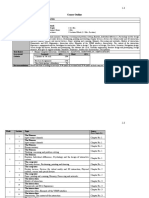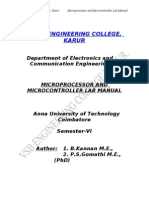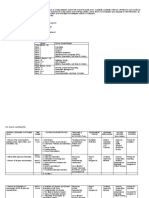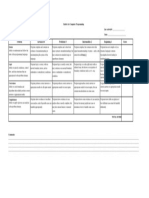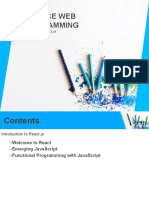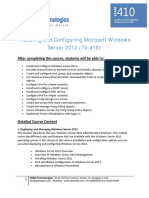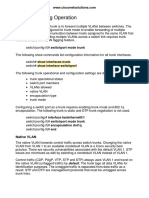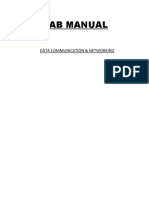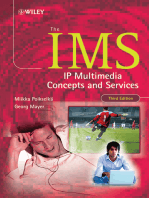0 ratings0% found this document useful (0 votes)
51 viewsFundamental of Network Security Syllabus
Fundamental of Network Security Syllabus
Uploaded by
rafael beto mpfumoThis course provides students with an understanding of fundamental network security concepts. Upon completion, students will be able to examine and describe general network security fundamentals and implement basic network security configuration techniques. The course objectives cover topics such as network devices, routing protocols, network topologies, IP addressing, subnetting, DHCP, NAT, packet encapsulation, OSI and TCP models, encryption, PKI, firewall configuration, and network monitoring.
Copyright:
© All Rights Reserved
Available Formats
Download as PDF, TXT or read online from Scribd
Fundamental of Network Security Syllabus
Fundamental of Network Security Syllabus
Uploaded by
rafael beto mpfumo0 ratings0% found this document useful (0 votes)
51 views1 pageThis course provides students with an understanding of fundamental network security concepts. Upon completion, students will be able to examine and describe general network security fundamentals and implement basic network security configuration techniques. The course objectives cover topics such as network devices, routing protocols, network topologies, IP addressing, subnetting, DHCP, NAT, packet encapsulation, OSI and TCP models, encryption, PKI, firewall configuration, and network monitoring.
Original Description:
....
Copyright
© © All Rights Reserved
Available Formats
PDF, TXT or read online from Scribd
Share this document
Did you find this document useful?
Is this content inappropriate?
This course provides students with an understanding of fundamental network security concepts. Upon completion, students will be able to examine and describe general network security fundamentals and implement basic network security configuration techniques. The course objectives cover topics such as network devices, routing protocols, network topologies, IP addressing, subnetting, DHCP, NAT, packet encapsulation, OSI and TCP models, encryption, PKI, firewall configuration, and network monitoring.
Copyright:
© All Rights Reserved
Available Formats
Download as PDF, TXT or read online from Scribd
Download as pdf or txt
0 ratings0% found this document useful (0 votes)
51 views1 pageFundamental of Network Security Syllabus
Fundamental of Network Security Syllabus
Uploaded by
rafael beto mpfumoThis course provides students with an understanding of fundamental network security concepts. Upon completion, students will be able to examine and describe general network security fundamentals and implement basic network security configuration techniques. The course objectives cover topics such as network devices, routing protocols, network topologies, IP addressing, subnetting, DHCP, NAT, packet encapsulation, OSI and TCP models, encryption, PKI, firewall configuration, and network monitoring.
Copyright:
© All Rights Reserved
Available Formats
Download as PDF, TXT or read online from Scribd
Download as pdf or txt
You are on page 1of 1
Palo Alto Networks Cybersecurity Academy - Network Security Fundamentals Syllabus
Course Description:
This course provides the student with an understanding of the fundamental tenants of network
security and covers the general concepts involved in maintaining a secure network computing
environment. Upon successful completion of this course, students will be able to examine,
describe general network security fundamentals and implement basic network security
configuration techniques.
Course Objectives:
Upon completion of this course students will be able to perform the following:
• Identify the common enterprise network devices.
• Differentiate between routed and routing protocols.
• Recognize the various types of area networks and topologies.
• Describe the Domain Name System DNS, FQDN, and IoT.
• Recognize decimal binary, and hexadecimal conversion methods.
• Describe the structure and fields of an IP header, IPV4, and IPV6 addresses.
• Subnet an IPV4 Class C addressing scheme and configure an IP address on the firewall.
• Review the four DHCP process messages and Network Address Translation (NAT).
• Setup the firewall as a DHCP server and test the DHCP client.
• Recognize packet encapsulation and the lifecycle process.
• Identify protocols and define the OSI and TCP model layers.
• Review the transport layer protocols, ports, and packet filtering procedures.
• Create and analyze packet captures using Wireshark.
• Classify various endpoint and network security technologies.
• Identify common network security encryption algorithms and key management concepts.
• Recognize symmetric/asymmetric key rotation techniques and PKI.
• Generate a Self-Signed Root Certificate Authority (CA) certificate.
• Create a decryption policy on the firewall to decrypt SSH traffic and SSL traffic.
• Describe the benefits of the next generation firewall single pass architecture.
• Identify the NGFW App-ID, User-ID, Content-ID and deployment options.
• Explore the five steps required to implement a NGFW zero-trust environment.
• Recognize network baselines, documentation, tools, and diagrams.
• Configure the NGFW to monitor, forward, and backup system logs (Syslog).
You might also like
- CGM V Sem Lab ManualDocument17 pagesCGM V Sem Lab ManualAkshat GiriNo ratings yet
- CCNA-4 Module 1-9 100%Document29 pagesCCNA-4 Module 1-9 100%danishsattar100% (5)
- Lab Activity 1: Topics: Java BasicsDocument2 pagesLab Activity 1: Topics: Java BasicsMaytor SmithNo ratings yet
- Digital Electronics Syllabus PDFDocument5 pagesDigital Electronics Syllabus PDFAvinash SinghNo ratings yet
- Syllabus Analog - Digital System Design PDFDocument9 pagesSyllabus Analog - Digital System Design PDFErkanNo ratings yet
- Course Outline HCIDocument3 pagesCourse Outline HCIIrtza SahirNo ratings yet
- Computer Security GoalsDocument72 pagesComputer Security GoalsAnkur Agrawal100% (2)
- Microprocessor and Microcontroller Lab ManulalDocument79 pagesMicroprocessor and Microcontroller Lab ManulalTamil VendhanNo ratings yet
- Second Syllabus CC 105 Information ManagementDocument6 pagesSecond Syllabus CC 105 Information ManagementMichaelangelo R. SerranoNo ratings yet
- MIT146 - Course SyllabusDocument2 pagesMIT146 - Course SyllabusFurqan Ali KhanNo ratings yet
- Module-1 PPT Data CommunicationDocument168 pagesModule-1 PPT Data CommunicationShruthi D100% (1)
- CC2063 Grid Computing Course PlanDocument3 pagesCC2063 Grid Computing Course PlanVanitha JanakiramanNo ratings yet
- Criteria Advanced 4 Proficient 3 Intermediate 2 Beginning 1 ScoreDocument1 pageCriteria Advanced 4 Proficient 3 Intermediate 2 Beginning 1 ScoreJonelNo ratings yet
- Group A Mysql Handout PDFDocument7 pagesGroup A Mysql Handout PDFAbhishek IcheNo ratings yet
- CN Lab Manual 2018Document121 pagesCN Lab Manual 2018Suresh RamanujamNo ratings yet
- MCSA in Windows Server 2012 R2 Course Outline PDFDocument5 pagesMCSA in Windows Server 2012 R2 Course Outline PDFChris BuenaventuraNo ratings yet
- CN Lab ManualDocument34 pagesCN Lab ManualChaya Bsvrj75% (4)
- Wordpress SyllabusDocument2 pagesWordpress SyllabusGaus PatelNo ratings yet
- Unit 1 - Chapter - 1Document23 pagesUnit 1 - Chapter - 1Shamanth EdgeNo ratings yet
- Switching TechnologiesDocument16 pagesSwitching TechnologiesPravallika MaddaliNo ratings yet
- CN Manual Lab (R20)Document85 pagesCN Manual Lab (R20)4416 LikhithaNo ratings yet
- CN Lab FileDocument22 pagesCN Lab FileaditiNo ratings yet
- 8086 Instruction SetDocument101 pages8086 Instruction SetSai Krishna Kodali100% (1)
- Windows Server 2012-70-410 SyllabusDocument4 pagesWindows Server 2012-70-410 SyllabusSenthil NathanNo ratings yet
- The TCM Security Pentester RoadmapDocument9 pagesThe TCM Security Pentester Roadmappahadiabhi1030No ratings yet
- CS6711 Security Lab Manual PDFDocument83 pagesCS6711 Security Lab Manual PDFelanthiraiyan elanthiraiyanNo ratings yet
- IT 12 Data Communication With Networking OBE Syllabus 1hourDocument8 pagesIT 12 Data Communication With Networking OBE Syllabus 1hourLawrence SisonNo ratings yet
- Csc261 CCN Lab ManualDocument125 pagesCsc261 CCN Lab ManualasadhppyNo ratings yet
- Unit 5 - Chapter 2 - Introduction To MongoDBDocument53 pagesUnit 5 - Chapter 2 - Introduction To MongoDBShamanth EdgeNo ratings yet
- Trunking Operation PDFDocument7 pagesTrunking Operation PDFDenis MsusaNo ratings yet
- Ip Security (Ipsec)Document18 pagesIp Security (Ipsec)gdayanand4uNo ratings yet
- Laboratory Activity Firewall IDS EncryptionDocument4 pagesLaboratory Activity Firewall IDS Encryptionjpermano24No ratings yet
- UNIT 6 Hardware & Software Concepts PDFDocument9 pagesUNIT 6 Hardware & Software Concepts PDFlavanyatumuNo ratings yet
- Iszc462 - Networkprogramming - Question PaperDocument3 pagesIszc462 - Networkprogramming - Question PaperShivam ShuklaNo ratings yet
- Ccs0003 Computer Programming 1 Lec SyllabusDocument6 pagesCcs0003 Computer Programming 1 Lec SyllabusAnonuevo June PaulNo ratings yet
- MiddlewareDocument31 pagesMiddlewareDon SunnyNo ratings yet
- Open Source SyllabusDocument2 pagesOpen Source SyllabusUmaMaheswariShanmugamNo ratings yet
- CH 1Document108 pagesCH 1Janhavi VishwanathNo ratings yet
- Computer and Network Security: Simplified Data Encryption Standard (DES)Document21 pagesComputer and Network Security: Simplified Data Encryption Standard (DES)Aisha Saman KhanNo ratings yet
- Unit 1 Algorithm Performance Analysis and MeasurementDocument61 pagesUnit 1 Algorithm Performance Analysis and MeasurementNone OtherNo ratings yet
- UNIT 3 DCN Class LecturesDocument101 pagesUNIT 3 DCN Class LecturesJyotiSharmaNo ratings yet
- CN Lab Manual FINAL 2018Document67 pagesCN Lab Manual FINAL 2018Harshitha SureshNo ratings yet
- C++ SyllabusDocument3 pagesC++ Syllabuspomar026No ratings yet
- E219483 Final Project Proposal 2024Document13 pagesE219483 Final Project Proposal 2024Ravindu PriyankaraNo ratings yet
- Lab ManualDocument32 pagesLab ManualyaseenNo ratings yet
- Computer Laboratory Manual: Fundamental of ICT Lab ManualDocument133 pagesComputer Laboratory Manual: Fundamental of ICT Lab Manualanon_510855877No ratings yet
- MIPS Assembly Language Programming: Computer Organization and AssemblyDocument33 pagesMIPS Assembly Language Programming: Computer Organization and AssemblySardar IrfanullahNo ratings yet
- CSC318 Web TechnologyDocument7 pagesCSC318 Web TechnologyMag CreationNo ratings yet
- 21CS52Document42 pages21CS52Sidharth PremdasNo ratings yet
- Spring UNIT VDocument14 pagesSpring UNIT VShamanth EdgeNo ratings yet
- UNIT-III Distributed Objects and Remote InvocationDocument60 pagesUNIT-III Distributed Objects and Remote InvocationsatyaNo ratings yet
- Sharing of Best Practices or Plagiarism?Document2 pagesSharing of Best Practices or Plagiarism?Mamidala Jagadesh KumarNo ratings yet
- Ge2112 Fundamentals of Computing and Programming: Introduction To ComputersDocument25 pagesGe2112 Fundamentals of Computing and Programming: Introduction To ComputerssanjeevnokiaNo ratings yet
- Difference Between Cache Memory and RegisterDocument2 pagesDifference Between Cache Memory and RegisterKhaled HossainNo ratings yet
- JNTUH Mobile Application Development SyllabiDocument2 pagesJNTUH Mobile Application Development SyllabiM NATARAJA SURESHNo ratings yet
- Chapter 6-2 - Network Components (Bridges)Document7 pagesChapter 6-2 - Network Components (Bridges)Afendey ArthurNo ratings yet
- Network Management System A Complete Guide - 2020 EditionFrom EverandNetwork Management System A Complete Guide - 2020 EditionRating: 5 out of 5 stars5/5 (1)
- Database Management System Technologies A Complete Guide - 2019 EditionFrom EverandDatabase Management System Technologies A Complete Guide - 2019 EditionRating: 5 out of 5 stars5/5 (1)





